I recently found a book called American Farm Implements and Antiques by C.H. Wendel. It reveals the background information on many old pieces of farm equipment dating back beyond the early 1800s. In it, I learned a lot about the history of farm machinery manufacturing. The book is well laid out with many pictures and descriptions of tools and the companies that made them. It appears that most of those early companies were glorified blacksmith operations. It also reminded me of two important this I had not thought of for a while.

In that book, I was reminded time and again of the ingenuity of American farmers and blacksmiths. Secondly, it repeated over and over the “forever” consolidation of the machinery business. It is no wonder that the primary goals of someone who invents a piece of farm machinery today is to first make some money, then sell it to one of the big manufacturers. It has been going on for almost 200 years. Two of the most prominent farm tools in the book (outside of tillage tools) are corn shellers and silage cutters. I also learned that silage cutters had a couple different names before they became silage cutters. Stover cutters and force feed cutters and a few other names and tools finally merged into what we call silage cutters today.
Back to silage in more recent times: As a kid who was 12 years old in 1963, I was assigned to run the silage cutter, a one row Allis cut and throw unit powered by a D17 Allis tractor. That Allis chopper model had basically been around since the ’30s and I had to read the manual to understand how to sharpen the knives because the cut and throw knives were sharpened inside the machine while it ran empty. The sharpener was built into the machine. You opened the cover over the knives and tipped the sharpener down on to the blades. The process was simple compared to some of the competition that had both a blower and a set of cutting knives that were separate but coordinated. After you sharpened the blades, you had to reset the sheer bar in front of the blades so that the cut was clean—50 thousandths between it and the knives, if I remember right.
As I read the manual, I was fascinated with all of the different lengths that you could set the machine to cut. As I recall (the manual disappeared long ago), you could set it from 3/8ths to 4 inches. We cut our silage somewhere between one-half inch and an inch. Since we were packing the silage in a pit, I had trouble understanding why you would make it any longer because it would be hard to get a good pack. (Our goal was to pile up 200 to 300 tons of silage a year.) I couldn’t imagine that an upright silo would be any different.
Years later, I learned from my father in law that they used to cut dry corn fodder in four inch chunks for dairy cows and stored it in the barn hay mow as late as the 1950s. That meant that they likely hauled the stalks to the chopper and used it as a stationary. The length of the cut was set by changing the chain and sprocket sizes on the feed rollers that fed the material into the knives. The faster that the feed rolls ran, the longer the cut. I always got a chill down my spine when I got close to those knives, even when they were stopped. They were nasty sharp.
That Allis cutter had a dog in the drive train that clattered when you shut the PTO off to let the blades slow down by themselves without dragging the PTO along. I loved the clatter of the dogs because it meant that the wagon was full or the row was done. Once in a while, you heard them because the head was plugged and you had to shut down to clean it out—no fun.
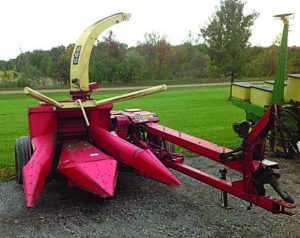
Dad had added two extras on to that chopper. He put a bumper on the back that allowed a truck to push up tight against the cutter so that you could blow the silage over the cab instead of onto the windshield. The truck was filled easier since the discharge was fixed to the rear of the chopper. Once in a while, the truck driver got carried away pushing the chopper across the field.
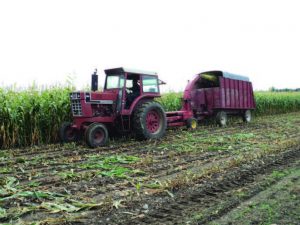
The second thing he added was from a Gehl chopper. That addition was a hitch release that allowed you to drop the wagon without getting off the tractor seat. You just pulled the rope and moved ahead. It also allowed you to back up to a wagon and snap onto the wagon hitch. Much easier that way.
We hauled with two wagons with false fronts and a 1949 Ford two ton truck that had a hydraulic hoist on a stalk and grain body. (The 1949 Ford had a flat head V8 and no muffler. You could hear it coming down the road a mile away above the noise of the chopper.) When loaded, the truck just backed up to the pit pile and ran up the hoist to dump the load. The wagons with the false fronts were another story. There was a pair of cables that laid on the wagon floor, attached to the false fronts that we hooked onto a chain to the pit tractor and pulled the load out the end gate. It was time and labor intensive.
Later we had wagons with hoists. The pit operator was responsible to pack and level between loads. A DU-AL loader on the pit tractor with a seven foot blade on the front made that easier. The pit operator was the crew boss. If you had a pit or bunker silo, a loader or dozer made life so much easier.
Some of the memories that come to mind from those years include getting stuck in the mud with a loaded wagon behind the chopper, vapor locks on the old Ford truck, getting stuck on the silage pile, flat tires and the awful sound of a hemp weed going through the cutter knives.
Our farm upgraded over time to a two, then a three row chopper. Today they hire a custom cutter.
In the mid ’50s, a neighbor had an 8N Ford tractor with a flat head V8 kit that boosted the power up so that they could pull a two row chopper. They used it with a fleet of dump trucks to cut corn silage for their feed lot. It was the talk of the neighborhood. That load must have to put a huge strain on every part of that 8N, especially the PTO. One thing about it—it was not hard to climb off the tractor to fix something. On the other hand, sitting that low pulling a chopper on a windy day had to be a dirty job.
I asked my grandfather about silage in his day, the ’20s and ’30s. He had a few good stories. Of course, at that time, they cut the corn stalk off near the ground with a corn binder, which bundled the stalks, then they loaded the bundles on wagons and hauled it with horses to a stationary belt driven cutter powered by a 12-24 Hart Parr. He told me that they had trouble finding someone to pack the pile they built on top of the ground. The pile was 50 to 150 tons, depending on how much dry hay they had. One year they hired a steam powered tractor and another year he found a guy with an “M” Allis crawler to pack it. They didn’t have any preservative or plastic (of course, since those had not been invented yet) so they topped the pile off with a little sand that they ran through the chopper blower and packed it tight using the weight and vibration of all the iron in that “M” crawler. He said that it was a very good seal and good silage.
In later years, they sealed it with molasses. The cattle liked the molasses mix, the spoilage was limited and it fed a lot of raccoon and deer.
From the early days and on into the ’70s and ’80s, if the corn crop was poor or was hailed or the corn was soft, farmers often cut it for silage and bought feeder cattle to sell the crop through the cattle. The competition drove the price of feeder cattle up and sometimes flooded the fat cattle market with oversized cattle due to the marketing strategies used. Today that does not happen very often due to the crop insurance program and the cost of starting a feed lot—just think permits.
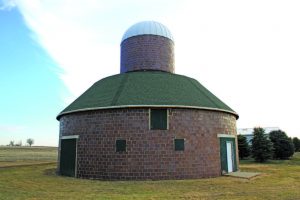
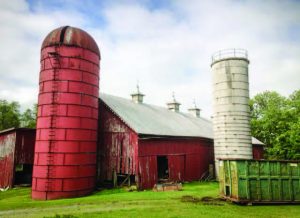
Over the years, we cut a lot of things for silage. That included oats, corn, alfalfa, rye, pasture grass, Sudan grass, grain sorghum, weeds and anything you could use for feed in a pinch. Silage not only made good feed, it was a way out of trouble at times. One year when I was about 4 or 5, we had a nasty drought in northeast Nebraska with temperatures as high as 113 degrees Fahrenheit. The corn never made it above four feet tall so we cut it two rows at a pass with the grass attachment on the same cutter I mentioned above pulled by a “WD” Allis in third gear. We topped it off with the only thing that grew—weeds, Russian thistle, sunflowers and the like. It worked. If you could not get something planted in time to make a crop, due to weather and or breakdown, it would always work as silage. If a crop froze early or was hailed, it would be silage—and so it went.
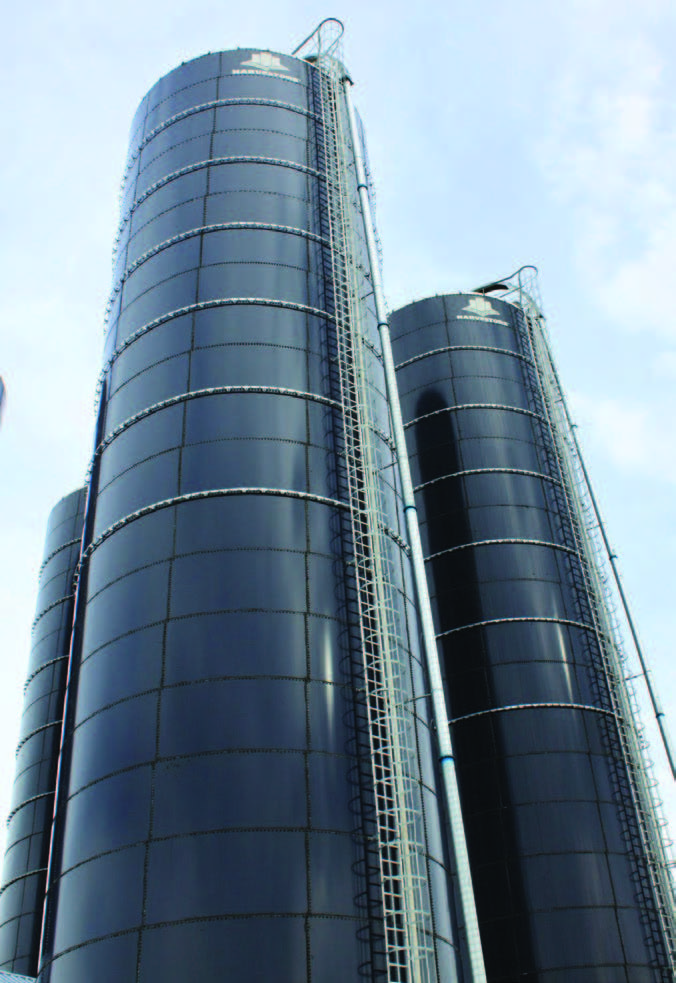
That approach has changed a lot over the years. Crop insurance has made things a lot different, especially for grain farmers. Making hay and silage helped us with weed control. For example, we had a bind weed problem in one field so we planted alfalfa and every time we cut it for hay or silage, the bind weed was set back. Over a few years, the bind weed finally died out. One of the best products to come out of a silo in the ’60s and beyond was corn earlege and high moisture corn. It was cheap storage and good feed that digested easily and saved on drying costs.
The danger of cutting corn for silage during a drought is the nitrates in the stalks, which can poison livestock and endanger the farm workers. The solution is to cut the corn stalk higher than usual because the nitrates are more concentrated in the lower stalk. After that, you need to allow the silage pile to age before you feed it so that the nitrates can be converted to gas during fermentation, which then escapes the pile,leaving safe feed for the livestock. These facts are the same as they have been for years.
The development of plastic cover material and preservative products to manage mold have improved the quality of the silage a lot. It is also true that the larger the pile of silage on the ground or in a bunker, the less the percentage of spoilage. The danger of a huge silage pile is that it can break loose and fall on someone as it did to one of our neighbors, leading to suffocation. Upright silos were excellent at keeping spoilage to a minimum, but they were not as cost effective as the plastic covered piles and bunkers. My father in law told me that with upright silos, you didn’t have to start a tractor to load silage in the winter—that was true. Upright silos, on the other hand, could have dangerous air pockets, silage frozen to the outside walls, poison gasses and occasionally the silage unloader fell on someone. They also were expensive to build.
The most interesting upright silo I have ever seen was a wooden stave silo built into the center of a round barn sometime in the early 1900s. (An old timer told me that barn cats did not like those round barn arrangements because there were no corners for relief—not sure how he knew that). That arrangement with the silo in the middle of the barn was efficient, especially if you were doing all the work by hand. It was also an efficient use of the heat from the livestock so that there was little frozen silage in the silo and in severe cold, the silo helped keep the barn warm.
At least two companies, other than Harvestore, built silos that were airtight and unloaded from the bottom. In extreme cold like you find in northern Minnesota and Wisconsin, you occasionally had to go to the hardware store to get some dynamite to solve the freezing and bridging problems at the bottom. Hopefully you knew what you were doing with the dynamite “solution.” God bless the guy who invented the silo unloader for upright silos, both top and bottom unloaders. They saved a lot of work and kept a lot of people safe from air pockets and poison gas. Airtight silos were an excellent way to preserve rolled high moisture corn and wilted chopped alfalfa. The resulting feed quality made them very useful for beef and milk production.
People experimented from time to time using the airtight storage to make feed out of unique things. The craziest story I ever heard about this was from a veterinarian in central Minnesota who told me about a broiler grower in his area who ran broiler manure through a Harvestore for fat cattle feed. He claimed it worked. Please pass the burgers—not.
The days of the upright silo and the blue silo have come and gone for the most part. If you want to be entertained by the passengers in your car or truck who have escaped the city for the weekend, ask them what “that thing” is. “That thing” can be an old upright silo or a pile of silage with plastic and tires on top. The answers they give are often hilarious. They get very confused when “that thing” is an old stave silo with a tree growing out of it. Near Carver, Minnesota, there is a Fleet Farm store with an old concrete stave silo standing near the entrance. As the suburbs have moved into the area, it must be amusing to hear city people explain “that thing” to each other.
Some other interesting developments in the world of silage include the rigs used to haul the chopped product to the storage pile. If you want to see the latest and the greatest, have someone invite you to the US Custom Harvesters convention in Sulfur Springs, Alaska next year. The latest machines are huge and amazing.
Things have changed since the days of the stover cutter that chopped one stalk at a time. Take a look at YouTube some time and see the amazing size of the equipment in operation. My favorite is the chopper that cuts 12 rows at a time and fills about six trailing wagons by blowing silage over the top of the six tractors pulling the wagons. Semi trucks with side dumps or trailers with chain aprons in the bottom are the new silage wagon. Choppers with 500 or more horsepower, pushing headers that have no snouts that can cut across the rows as easy as they cut following the rows are common. Five or six hundred horsepower four-wheel drive tractors with triples and 16 to 20 foot dozer blades pushing silage on the pile and packing at the same time are common.
Did I mention three or four separate roller mills in one machine that works to fill a pit with a million bushels of corn? How about this? A company in Texas is adding acid to silage to create a new source of energy from million ton piles of silage. Who would have thought that would happen?
Companies with feed lots holding 100,000 to 200,000 head of feeder cattle or dairies with 15,000 milk cows sometimes hire multiple contract crews that come from as far as three states away to fill their silage bunkers and pits with feed to keep all those rumens busy making beef and milk. I know of contractors who have been making trips like that for 20 years. (No one mentions stover.) The largest contractor I know about is in California and they run 17 big choppers. Only they know how many trucks they need to keep that operation going. Three lost hours today for a chopper and two trucks costs more than the entire value of the list of equipment we used to cut silage in 1962. It costs a contractor $3,500 per hour to have a chopper down and $900 per hour to have a truck down. Times have changed.
